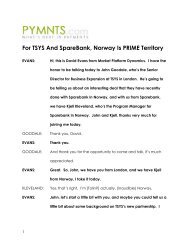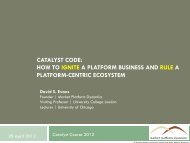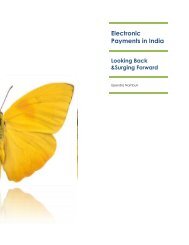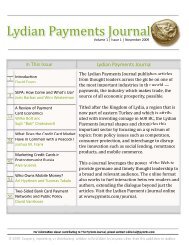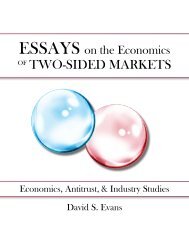Interchange Fees: The Economics and Regulations of What
Interchange Fees: The Economics and Regulations of What
Interchange Fees: The Economics and Regulations of What
- No tags were found...
Create successful ePaper yourself
Turn your PDF publications into a flip-book with our unique Google optimized e-Paper software.
16 INTERCHANGE FEESneed to balance the supply <strong>and</strong> dem<strong>and</strong> <strong>of</strong> card transactions. This seems somewhat artificial, sinceas long as some merchants have agreed to accept a card, the volume <strong>of</strong> transactions is determinedunilaterally by card-carrying consumers’ deciding whether or not to use the card for particulartransactions. Nonetheless, the proposition that at some interchange fee levels the system wouldnot be viable is likely to hold in more general models. <strong>The</strong> important—<strong>and</strong> robust—insight fromBaxter’s analysis, although it is not framed precisely this way, is that the interchange fee helpsinternalize an externality between the two customer groups <strong>and</strong>, in so doing, has the potential <strong>of</strong>making both customer groups better <strong>of</strong>f.C. Imperfect Competition in Issuing <strong>and</strong> Acquiring<strong>The</strong> assumption <strong>of</strong> perfect competition between homogeneous issuers <strong>and</strong> acquirers is notrealistic <strong>and</strong> leads to most interesting questions having indeterminate answers—since there areno pr<strong>of</strong>its to be had, there is no motivation for doing anything. <strong>The</strong> next logical step was takenby Richard Schmalensee. 40 He made the st<strong>and</strong>ard assumption that, except for the payment systemunder study, the economy was perfectly competitive. 41 This implies that the dem<strong>and</strong> systemfacing the system, which Schmalensee took as given <strong>and</strong> did not derive from first principles,could be used for st<strong>and</strong>ard welfare analysis. Schmalensee allowed for imperfect competitionamong issuers <strong>and</strong>/or among acquirers <strong>and</strong> made a particular assumption about the functionalform <strong>of</strong> the dem<strong>and</strong> system <strong>and</strong>, thus, about the structure <strong>of</strong> indirect network effects. As in theBaxter analysis, the system itself was assumed to operate like the Visa <strong>and</strong> MasterCard systemsoperate in fact, on a break-even basis, <strong>and</strong> fixed costs <strong>and</strong> access prices were again assumed away.Thus, as in the numerical example above, the interchange fee simply shifts costs between issuers<strong>and</strong> acquirers, raising costs on one side <strong>of</strong> the market by exactly as much as it lowers costs onthe other side.In this model, the level <strong>of</strong> the interchange fee can affect the pr<strong>of</strong>its earned by issuing <strong>and</strong>acquiring banks whenever competition among them is imperfect, making it possible to comparepr<strong>of</strong>it-maximizing <strong>and</strong> welfare-maximizing fees. Under some special assumptions, the comparisonis simple: when there is a single issuer <strong>and</strong> a single acquirer <strong>and</strong> dem<strong>and</strong> curves are linear,for instance, Schmalensee shows that the pr<strong>of</strong>it-maximizing interchange fee also maximizes systemoutput <strong>and</strong> economic welfare. In this case, regulation could only reduce overall performance.In general, however, these three fees may be different even under the particular dem<strong>and</strong>structure Schmalensee assumed, <strong>and</strong> even when the further assumption <strong>of</strong> linear dem<strong>and</strong> isimposed. Thus, even under strong assumptions about dem<strong>and</strong>s <strong>and</strong> costs, the relations among40Schmalensee (2002).41Much <strong>of</strong> the subsequent literature has persuasively called that st<strong>and</strong>ard assumption into question in this context, aswe discuss in the next section. Nonetheless, it is instructive to see its implications before considering how it might bealtered in the direction <strong>of</strong> greater realism.



